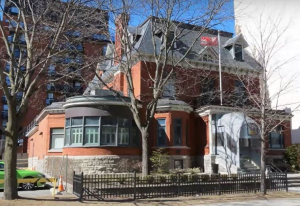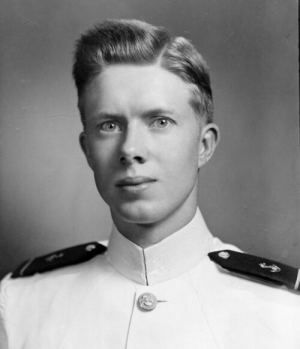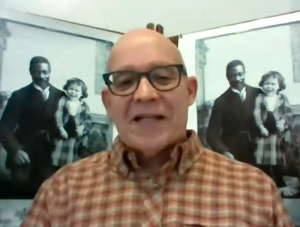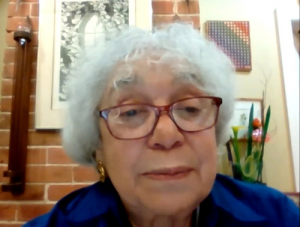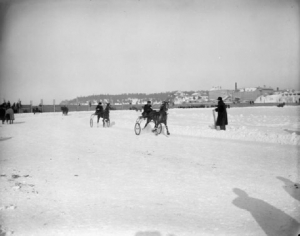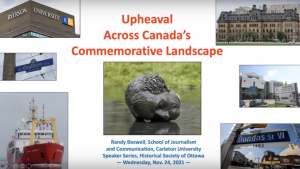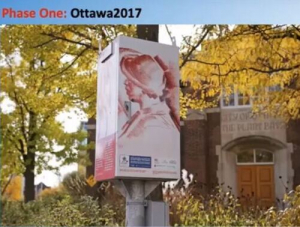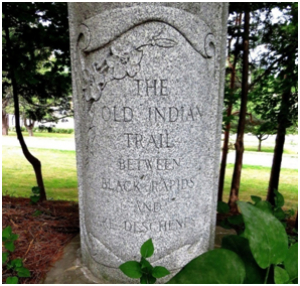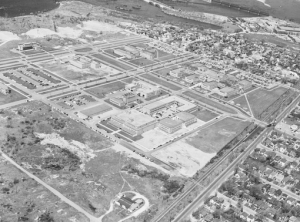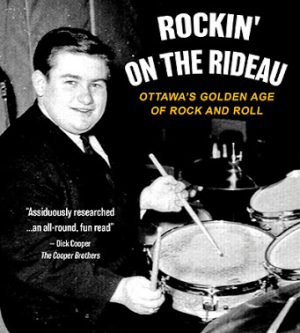Richard Collins
Ottawa’s Landmark Homes
Ottawa is one big graveyard! Cemeteries are peaceful. Some like to stroll among the dearly departed to get away from the noise and chatter of daily life. Historians, on the other hand walk among the graves hoping that the tombstones will tell a story of those below.
I feel the same way when I walk the streets of Centretown, Lowertown, Sandy Hill, and Hintonburg. Old houses are my memorials to the past. Big or small, elaborate or modest, Ottawa’s houses of the 19th and early 20th century tell us how the people who lived in them . . . lived. To me cemeteries are about death. But the homes of those now gone are about the life that they chose or inherited.
For the HSO March 13, 2024, Zoom presentation, I took people on a journey of the residences that were once a place of relaxation after a hard day at the office . . . or store, or operating room, or laboratory, or forest. The unadorned elegance of homes in Lowertown – some of wood, others of stone – reveal the modest lifestyles of Ottawa’s labourers and lower management civil servants.
Brick, on the other hand, was the preferred choice for the upper crust of Upper Town. The streets of Centretown run red with Edwardian masterpieces. These homes hint of a congenial social norm where the women played Whist in the parlor, while their husbands discussed the rising or falling business climate in the sitting room across the hall.
At the southern extremity of the Bank and Elgin streetcar lines, Glebe became the exclusive domain of brokers and bankers. These people could afford the services of local architects like Werner Noffke and William Caven Beattie, who were commissioned to design “revival” homes in colonial and Classical styles, and to avoid, at all costs, the staid British styles of the “old money” families.
Part One of Who Lived Here? can be seen at the HSO YouTube website.
Jimmy Carter: Chalk River and Beyond
Over the years, the Historical Society of Ottawa has had many presentations about people who have had a significant impact on the history of Ottawa and the Ottawa Valley, and we’ve always been able to count on guest speakers who have researched their subject well, but its quite rare to have a presentation from a speaker who personally knows the subject of the presentation and has had that historic person as a guest at his Kingston home. In fact, for our Oct 26, 2022 Zoom presentation we had two speakers with first-hand knowledge of their subject.
Arthur Milnes considers former US president Jimmy Carter to be a friend. He has had many interviews with the 39th president since first attending one of Carter’s Sunday school classes in 2002, and has been invited to the home where Jimmy and former first lady Rosalynn still reside.
Arthur is the author of 98 Reasons to Thank Jimmy Carter. Arthur chose that number because his recently-published book came out soon after the former president’s 98th birthday.
So what does a US president have to do with Canada, and the Ottawa Valley in particular? Well, you may recall from a post at the HSO’s Facebook page about a year ago (the post received a million views on Facebook and millions more on Twitter!) that Carter was a lieutenant in the US Navy in 1952, and was placed in charge of an emergency radioactive clean-up at the Chalk River Nuclear Laboratories, that year. In this presentation, Arthur left it to Carter himself to give the details of the event, via YouTube.
Joining Arthur for the evening was Jill Stuckey. She is the superintendent of the Jimmy Carter National Historical Park. She joined us from Plains, Georgia; the hometown of President Carter. Jill took us on a quick tour of the museum, which is located in the high school that both Rosalynn and Jimmy attended. Jill had a meeting earlier that day with the former president and first lady, and they asked Jill to be sure to say hello to everyone watching Arthur’s presentation.
Also on the line for the evening was Morgan Brown, who is the president of the Society for the Preservation of Canada’s Nuclear Heritage. Morgan joined us to offer some details on the technical aspects of nuclear reactors and how decisions regarding their operation affected Lieutenant Carter’s efforts at Chalk River. Brown’s society faces the difficult, but important challenge of preserving a part of history that some Canadians would like to forget, or imagine didn’t happen. But it’s important to note that Canada played an early critical role in nuclear research, with Chalk River as the centre of that activity. Without that early contribution to nuclear research, a US president might never have become an important part of Canadian history.
Thank you to all three of our guests for a lively and informative presentation.
You can view the full presentation on the HSO YouTube channel.
See also: Jimmy Carter and Canada via YouTube. And The Society for the Preservation of Canada's Nuclear Heritage for a virtual tour of their museum in Deep River.
The Barber Family: A Proud Place in Ottawa’s History
Thomas Barber is proud of how much the Black community in Ottawa has prospered over time. Thomas tends to look at a darker past not with anger or bitterness. Instead he tends to see Black History in Ottawa as a series of challenges overcome and lessons to be remembered. Understanding the past is key to measuring how far we’ve all come in establishing a more inclusive community, and it’s to our benefit that Thomas relates the past with insight and humour.
Much of Thomas’ presentation highlights his family members' journey confronting prejudice and overcoming these obstacles, but Thomas started his presentation with a history of the many cultures that make up Ottawa, the problems they faced moving here, and how they took on these challenges.
People from all over the world have been coming to Canada for over 200 years, but Thomas focused his attention on why they chose Canada over other places, and (most importantly to Thomas) what these people of such diverse heritage did to make Canada a better place for themselves and for others.
Thomas is the right person to tell this story of his family's achievements. He’s done the research with passion and a dedication to accuracy.
The family of Thomas’ grandfather Paul Barber were one of earliest of African descent to settle in Ottawa. In Thomas’ presentation to the HSO, he talks about how his grandfather had been taught a particular trade by his Kentucky slave-owners and how, after Emancipation, Paul Barber came to Ottawa and earned respect as an expert in this trade as a free man in Canada.
It’s a wonderful story of how one person prospered through adversity, and how Paul Barber passed this tradition of hard work and resilience down through his family.
You can view the full presentation in the video section of the HSO website.
We Are the Children: Coming To Terms With Our Past
In honour of Black History Month in Canada, both of our guest speakers for February discussed the history of Ottawa's Black community — one that is growing both in numbers and influence in our culturally-diverse city, and of the challenge of confronting prejudice and exclusion in the past.
June Girvan is an award-winning educator, activist and community leader who came to Ottawa from Jamaica almost 70 years ago. June is the president of Black History Ottawa (a non-profit organization dedicated to carrying out research in the history, culture, traditions and achievements of Canadians of African descent) and founder of J’nikara Dinqinesh Education Centre.
In June’s presentation, she shared her personal journey. In June’s own words we heard of the struggles and successes that she and others have seen in their lifetimes..
June also spoke extensively of the challenge for people of African descent to now come to terms with streets signs and tributes in their neighbourhoods, that honour the names of those who held their ancestors as slaves.
We need to better understand and reconcile the co-incidence between the street names of Ottawa, inherited slaveholder family names of Black children, and the names of those who appear in the British Slave legacies database.
June urged that we consider the impact of the of these names in ensuring that Ottawa "is experienced as a safe, friendly community by children of all human colours of the sun".
You can find the conversation with June in the video section of the HSO website.
Sports Vignettes from Old Ottawa
Football fans in this town have managed to remain loyal to their home team for 145 years, be it the Rough Riders, or the Renegades, or back again to the Rough Riders, and now the Redblacks. Hockey fans have retained their allegiance to two different Senators teams over 80 seasons, separated a by a 58-year winter when locals were forced to chose between the Leafs, Habs, or other members of the Original Six. But as we learned at our January 26th presentation, Ottawa’s sports history is much more than hockey and football.
Our guest speaker for the January 26, 2022, Virtual Speaker Series was HSO member James Powell, who began his presentation by reminding us that in the late 19th century, watching professional sports was not nearly as popular as participating in amateur pastimes like lacrosse, cricket, and cycling. As James noted, skiing was a popular pastime in Ottawa before devotees could even come to agreement on how to spell the name of their favourite sport.
As always, when it comes to James’ presentations, his history is well researched. During the Q&A session that followed, one participant though he might have stumped James with a question regarding the obscure sport of “hose reel racing” which was held annually in Ottawa a century ago. Suffice to say, James had an answer. I won’t tell you here what hose reel racing is. You’ll find it more entertaining to watch James’ presentation for the answer.
Like all our Virtual Speaker Series presentations, you can find James’ talk at our HSO website. The website is also the place to register for upcoming presentations.
Upheaval Across Canada’s Landscape of Commemoration
Randy Boswell highlights the opportunity to find deserving figures "other than Victorian-era politicians, government functionaries and members of the British mobility" to name our landmarks after. Randy had been one of the first to propose, in a 2020 Ottawa Citizen column, to rename Ottawa's Prince of Wales Bridge in honour of Chief William Commanda.
Randy, a past member of the HSO Board of Directors, draws attention to the way "the naming of streets, buildings and other places has sometimes memorialized slave owners and other unworthy figures from the past" and suggests replacing implied tributes to "historical figures (Henry Goulbourn, for example) with deeply problematic past and little or no connection to our country".
In other cases, Randy advocates a delicate balance, with figures such as Sir John A. Macdonald, to "find ways to preserve pride in the achievements of Canada's founding prime minister without ignoring his role in shaping the Residential Schools system and other racism-laced policies targeting Indigenous and Chinese people."
(At the start of his presentation, Randy acknowledges that there exist a wide range of views on this topic and invited audience members to join the conversation during the Q&A session following his talk.)
Since the HSO's founding almost 124 years ago with our mission to “increase public knowledge of the history of Ottawa” and “to preserve the history of the peoples of Bytown and Ottawa”, we have frequently been guilty of telling Ottawa's stories from a very narrow cultural perspective.
We can't "erase" the past in terms of erasing what has already been written. But we need now to expand upon what has been written -- and update the record of our past with the important perspectives that thus far have been glaringly missed from our history books.
We need to understand, acknowledge and come to terms with our past -- as historical society, as a city, and as a nation.
Randy, a journalist and Carleton University professor, notes that we should be at liberty to override some of the naming choices made by our Victorian-era forebearers that date back to a very different colonization era.
Randy's presentation recognized the difficult task ahead for Ottawa’s politicians, city planners and community groups (including HSO) in setting new, inclusive standards on how to honour the past, into the future.
Capital History Kiosk Project
They’re easy to spot when you’re walking along any of Ottawa’s busy streets. They’re designed to be recognized.
Our October 13, 2021 presentation is about the traffic control boxes at many of Ottawa’s intersections; not of the drab utility boxes themselves, but about the colourful history lessons that have been applied to them to remind you of what Ottawa used to look like 10, 50, or 100 years ago, and to tell the story of a significant event that took place near each control box.
David Dean has been a professor of History at Carleton University since 2000. He got the kiosk project moving forward in 2015 with utility boxes along Bank Street, to tell the story of the local businesses. This early stage was completed in collaboration with the Workers History Museum and the Carleton Centre for Public History. The Capital History Kiosk Project expanded city-wide in 2017, as part of Canada’s 150th Anniversary celebration.
Danielle Mahon is an MA student as Carleton. She talked about the process of gathering information on each kiosk, and uploading location information on the kiosks to the Capital History website, at www.capitalhistory.ca. Students have also assisted in the project to add QR codes at each traffic box so that pedestrians can scan the code with a cell phone to read more about the history depicted at each box.
Being the national capital, there is no shortage of stories to tell about Ottawa, and fortunately there is no shortage of control boxes. David notes that the city as about 19,000 of them. The kiosk project is expanding as more research is done, so don’t be surprised if you see a new one next time your walking, jogging, or cycling around town.
Visit the HSO YouTube channel for to view the full presentation about the Capital Kiosk Project.
Mapping the Ottawa Valley’s Ancient Indigenous Trails
HSO Presentation Wednesday, November 17, 2021
Imagine going online 500 years ago to find something on Google Maps. You’d see no grid of streets with familiar, mostly British names; no array of colourful icons directing you to coffee shops or LRT stations. What you’d have seen then is a vast wilderness broken only occasionally by a few narrow, meandering paths. These trails were winding, not because the trail makers were lost, but because the trail makers were following the path of least resistance. To the Anishinabe traders, trappers and hunters, it made more sense to go around a steep hill rather than over it. It was easier and safer to go out of your way to cross a river at its narrowest or calmest point.
The Indigenous trails that criss-crossed the Gatineau and Ottawa valleys were ignored in later centuries by civil engineers and town planners who preferred their roads to be as straight as possible, regardless of the lay of the land. As a result, the early trailways of the Ottawa area have all but vanished, but thanks to Dr. Peter Stockdale, they’re coming back to life.
Peter is continuing his research to find the routes used by the Anishinabe, to have these trails marked with informative plaques, and where possible turned back into public trails for recreational use. Peter is the founder of Kichi Sibi Trails.
In his research, Peter has confirmed that there are different types of Indigenous trails. Portage trails cross the highland between watersheds. Ritual trails were often challenging walks that lead to remote vistas were the solstice and equinox events could be watched. There are also possible “war paths” that the Anishinabe of this area may have used as much for defence as for attack. Peter is still looking into the heritage of these types of trails.
We were also fortunate to have Barb Sarazin and Merv Sarazin join in on Peter’s discussion. Barb and Marv are current councilors of the Algonquins of Pikwakanagan First Nation. Barb told a personal tale about her family and how they came to be involved in the affairs of the First Nation. Merv talked about his preferred way to get around; which is by canoe. Although land trails that Peter has been investigating were necessary to get to final destinations, the rivers and streams were the main highways for Anishinabe travelers. Merv has been making canoes since we was a child.
Find out more about the ongoing work that Peter and his team at Kichi Sibi Trails have undertaken at the Kichi Sibi Trails Facebook page.
Check out the HSO YouTube channel for a video of the full presentation.
Tunney’s Pasture - The Story Behind Ottawa’s Field of Dreams
If there’s one area of Ottawa that seems devoid of history, it’s easy to imagine Tunney’s Pasture being that place, but our September 29th guest speaker, Dave Allston managed to add some humanity to the story of an area famous for its dehumanizing buildings and wide, vacant parks. Tunney’s Pasture has a much richer history than you might expect.
Dave is a long time resident of Ottawa’s west end, and maintains a website, The Kitchissippi Museum, dedicated to telling the stories of communities like Hintonburg, McKellar Park, and Britannia.
A number of developers in the early decades of the 1900s had dreams of building neighbourhoods in Tunney’s Pasture but these failed. A few factories moved into the area, close to the railway tracks, but otherwise the area remained as its present name suggests: acres and acres of pasture. When a small community finally did develop during the Depression it was an isolated collection of shacks, forgotten by following generations. These homes remained in dwindling numbers until the late 1950s when they were finally removed by the federal government when the office development went up. Dave’s presentation included some touching photos of the poor families that managed to eek out an existence in homes without heat, electricity, and running water. At a time when even Ottawa’s finer neighbourhoods were suffering through a deep Depression, the residents of Tunny’s Pasture had a particularly sad tale to tell. Yet as Dave noted in his presentation, the people in his collection of rare photos all seem to be smiling.
It makes you think that perhaps Tunney’s Pasture was not so bad a place at all. Certainly Dave’s presentation proved that Ottawa’s enclave of office towers has an interesting past.
Visit Dave’s website at kitchissippimuseum.blogspot.com for more stories about Tunney’s Pasture and of Ottawa’s other west end communities.
Check out the HSO YouTube channel for a video of Dave's full presentation.
Jim Hurcomb: Rockin' on the Rideau
You can say that the Historical Society of Ottawa’s guest speaker for September 15, 2021 is certainly an accomplished speaker. From 1973 to 1980, Jim Hurcomb was a familiar voice on CKCU-FM, Radio Carleton. From 1980 to 2000, Jim hosted a number of programs on CHEZ-106, including the morning show, and the afternoon variety show, In the City. From 2000-2008, Jim worked at CFRA Radio.
In all these years of jockeying everything from vinyl records to MP3s, Jim has gathered a wide collection of memories of the music scene in Ottawa. Did you know that Elvis Presley performed live only three times in Canada, and that one of these stops was at the old Auditorium on O’Connor Street?
Although Jim talked briefly about the big stars who visited Ottawa, the main theme of Jim’s presentation was Ottawa’s hometown bands. Most were short lived groups whose hits played only on the local stations. One of these, The Staccatos had a song, titled Signs that did not do well. Then the band took on a new name, The Five Man Electrical Band. They re-released Signs and this time around it went to the top of the Canadian and US charts.
Paul Anka is perhaps Ottawa’s most famous songwriter. His songs were hits in the US and Europe, but Anka was not well respected in his home town. As Jim noted, the movement in music in Ottawa was towards a hard-driving rock sound, while Anka was writing popular, but otherwise conventional love songs that didn’t have the kind of edge Ottawa’s music fans were craving.
Jim’s presentation was only able to scratch the surface of Ottawa’s music scene, but you can read more about Ottawa’s early rock and roll history in his new book, Rockin’ on the Rideau, available at amazon.ca or at local bookstores. You can also catch Jim on LIVE 88.5, Sunday nights at 9 pm for his show, The Sound of the Underground.
You can watch the full presentation on our YouTube channel.



